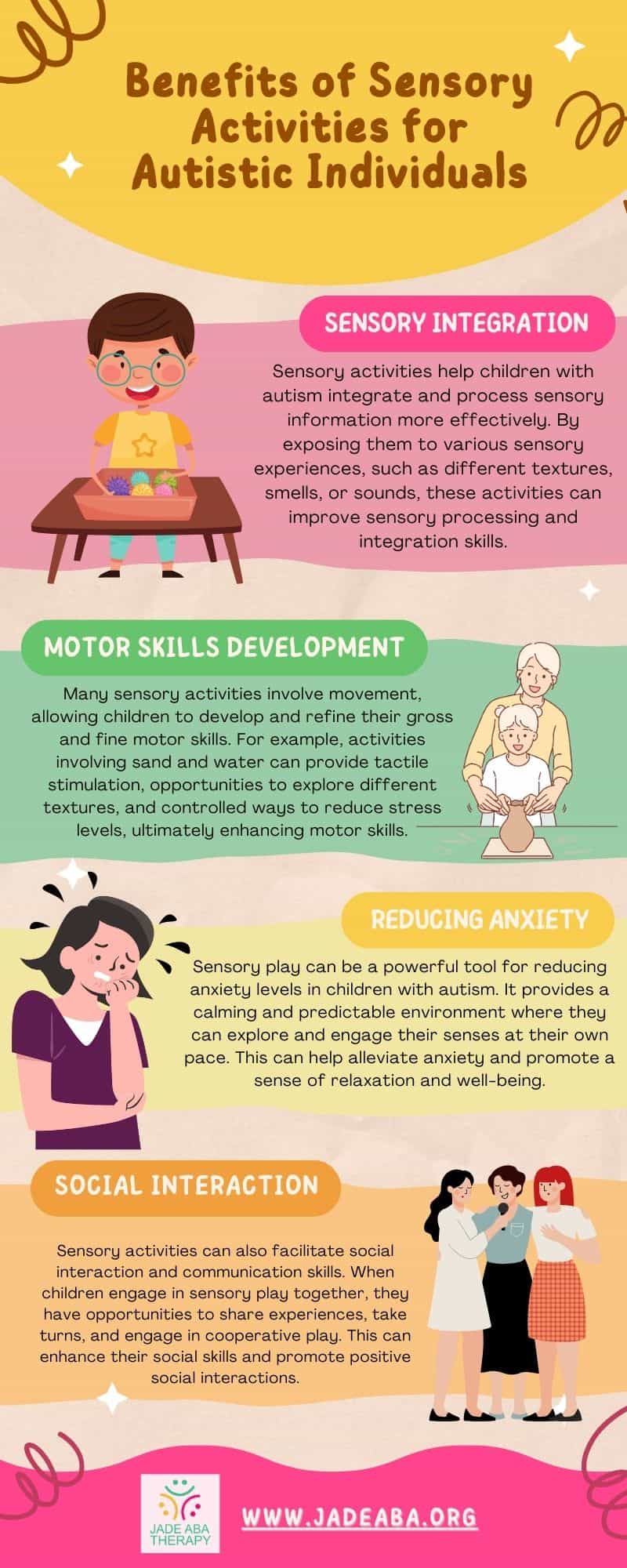Children with autism often have difficulty understanding and managing their senses which can then lead to anxiety or frustration. With sensory play, they can have a safe space to explore different sensations in a controlled manner, helping them learn about the world around them and engage their senses through touch, taste, smell, and sound.
Sensory activities like water play can be crucial for autistic children as they encourage exploration and learning through movement. For instance, filling a kiddie pool, using kitchen items to explore in the bathtub, or observing moving water such as streams or fountains can engage children’s senses and promote sensory development.
This type of play helps children with autism develop a better understanding of their own sensory preferences and sensitivities, leading to improved self-regulation and emotional well-being.
Here, we’ll look at some of the best sensory exercises for autistic individuals.

Water Play
Water play is a versatile and calming sensory activity for individuals with autism. It encourages exploration and learning through movement while providing a safe and soothing experience.
There are various ways to incorporate water play, such as filling a kiddie pool, using kitchen items to explore in the bathtub, or observing moving water sources like streams or fountains.
This activity allows individuals to engage with different water textures and temperatures, promoting sensory awareness and relaxation.
Sensory Play-Dough
Sensory play-dough is a fantastic tool for individuals with autism to engage their senses and develop important motor skills. It aids in reducing anxiety levels, building concentration skills, and allowing individuals to focus on one task at a time.
This can be particularly helpful in managing overwhelming situations.
Sensory play-dough is available in different colors and can be enhanced with various scents or textures to cater to individual preferences. Through manipulating and shaping the play-dough, individuals can improve their fine motor skills and engage in a calming and creative activity.

Sand and Water Exploration
Activities involving sand and water provide autistic individuals with ample opportunities for tactile stimulation and sensory exploration. These activities can be versatile and engaging, catering to individual preferences and needs.
Sandboxes or sensory tables filled with sand and water allow individuals to explore different textures, build structures, and engage in imaginative play. This controlled environment provides a sensory-rich experience and can help reduce stress levels.
Sand and water exploration activities can be particularly beneficial in promoting sensory integration and enhancing fine motor skills.
Painting with Feathers
Painting with feathers can serve as a therapeutic and creative sensory activity for individuals with autism. This activity helps develop fine motor skills, boost creativity, and improve focus on creating art.
By manipulating the feathers and observing the different textures they create on the canvas or paper, individuals can engage their senses and explore shapes and colors. Painting with feathers allows for a unique sensory experience that combines visual and tactile stimulation.

Sensory Activities for Adults with Autism
Adult individuals can also benefit greatly from engaging in sensory activities tailored to their specific needs. These activities can provide a sense of calm, promote relaxation, and enhance overall well-being.
Let’s look at some of them:
Deep Pressure Activities
Deep pressure activities involve applying pressure to the body, which can have a calming effect on individuals with autism. These activities can include:
- Weighted blankets – The use of weighted blankets has been shown to provide a sense of comfort and security, promoting relaxation and better sleep quality.
- Compression clothing – Wearing compression clothing, such as compression shirts or vests, can provide a gentle, consistent pressure that can help reduce anxiety and improve focus.
- Squeezing exercises – Engaging in activities that involve squeezing, such as using stress balls or hand exercisers, can provide deep pressure input and help regulate sensory input.
DIY Sensory Activities
DIY sensory activities can be cost-effective and customizable to meet the specific sensory needs and preferences of adults with autism. These activities can include:
- Sensory bins – Creating sensory bins with materials like rice, beans, or sand can provide tactile stimulation and encourage exploration and sensory play.
- Sensory bottles – Making sensory bottles with a variety of materials, such as glitter, water beads, or small objects, can provide visual and auditory stimulation, promoting relaxation and focus.
- Texture boards – Constructing texture boards with different textures, such as fabric, foam, or sandpaper, can offer tactile stimulation and help individuals with autism explore different sensations.
Adult-Focused Sensory Activities
These activities can help improve body awareness, reduce anxiety, enhance coordination and balance, and provide a sense of control and relaxation among autistic adults. Some examples include:
- Yoga – Engaging in yoga can promote body awareness, flexibility, and relaxation through gentle movements and focused breathing.
- Massage – Receiving massages can provide deep pressure input, relieve muscle tension, and promote relaxation.
- Aromatherapy – Utilizing scents through essential oils or scented candles can have a calming effect and enhance the sensory experience.
- Dance parties – Participating in dance parties or rhythmic movement activities can provide sensory stimulation, improve coordination, and elevate mood.
Incorporating these sensory activities into the daily routine of adults with autism allows parents to create a supportive and enriching environment that caters to their children’s unique sensory needs.
These activities can promote relaxation, reduce anxiety, and enhance overall well-being, allowing individuals with autism to thrive and enjoy a fulfilling life.
Benefits for Individuals with Autism
Engaging in sensory activities provides numerous benefits for individuals with autism. Here are some of them:

By recognizing and addressing the sensory needs of individuals with autism through sensory activities, we can provide them with a supportive and enriching environment. Sensory play allows individuals with autism to explore and learn about the world in a way that is safe, enjoyable, and tailored to their individual needs.
Sources:
https://www.thefca.co.uk/fostering-autistic-children/sensory-activities-children-autism
https://www.autismspeaks.org/blog/10-sensory-activities-for-autism
https://www.integrityinc.org/7-sensory-activities-for-adults-with-autism
https://likefamily.com.au/blog/7-engaging-sensory-activities-for-autistic-kids